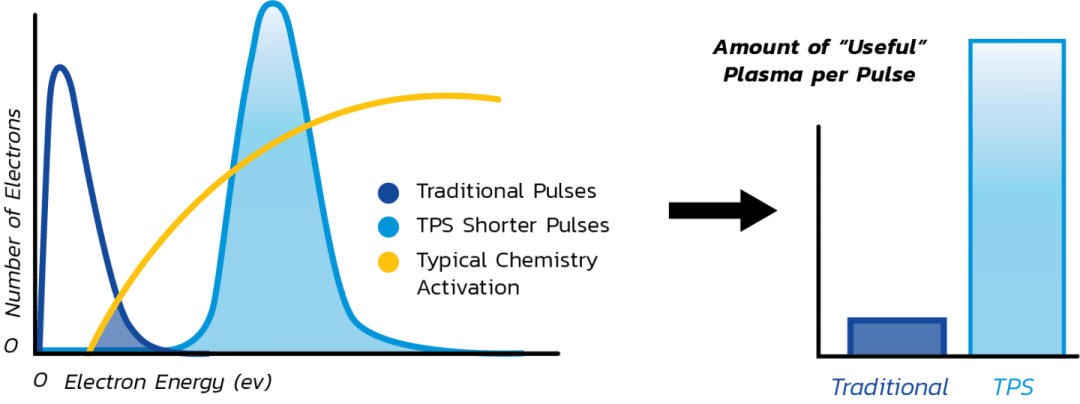Transient Plasma: Advantages and Applications
The Transient Plasma Papers | Volume 1, Part 2 — October 2019 | Advantages and Applications Series
In the first installment of this series, we explained how atmospheric-pressure plasma systems are used in many industrial environments, the benefits they provide, and the challenges of generating and maintaining a low temperature non-thermal equilibrium plasma.
We also introduced transient plasma systems to the discussion and briefly explained their comparative advantages: They are inherently more stable and more versatile than the more-prevalent atmospheric-pressure plasma systems used in industrial environments today. In this installment, we’ll dive deeper into the differences and value propositions of transient plasma systems used in industrial environments.
Read the Other Installments:
The Fundamental Differences of Transient Plasma
Traditional industrial atmospheric-pressure plasma systems have a narrow operational range (e.g. limits on peak voltage, gas flow, duration) that restricts the amount of energy that can be delivered to the plasma without resulting in potentially damaging thermal instability. In a transient plasma system, this risk of thermal instability is minimized, resulting in a much more tunable plasma.
A transient plasma system is fundamentally different because each high-voltage pulse is applied for only 10-20 nanoseconds. During each incredibly fast high-voltage pulse, the extremely lightweight electrons rapidly gain the energy needed for industrial applications. However, the comparatively massive ions don’t have time to absorb energy, and they are effectively stationary during the pulse.

Transient plasma systems also provide benefits between each short duration high-voltage pulse. When energy is not being applied to the plasma, electrons and ions have plenty of time to recombine and relax in their previous states. During these resting phases, the desired chemical reactions and processes are still driven by electrons. However, the heating of ions is dramatically reduced, and arc formation — which typically takes many microseconds to occur — is eliminated altogether.
Thus, the operational window for transient plasma is much broader than that of atmospheric-pressure plasma driven by long-duration pulses or continuous alternating high voltages. A stable, useful plasma can be achieved over a wider range of applied voltage amplitudes and pulse-repetition rates.
What’s more, a stable and repetitively pulsed transient plasma can be achieved with various input gases, such as argon or helium, over a wide range of gas-flow rates. These factors represent another key advantage of transient plasma over atmospheric-pressure systems that use argon and helium. Some atmospheric-pressure plasma systems use compressed air as an input gas, which is much cheaper to use. However, the plasma streams generated by these systems are typically of a much higher temperature and do not project as far, which requires a closer treatment distance. As such, transient plasma systems support a wider range of treatment temperatures and distances.

The Fundamental Differences of Transient Plasma
Transient plasma systems have fine-tunable energy: The energy gained by the electrons is directly influenced by the magnitude of the peak voltage. In a transient plasma system, the peak voltage can be adjusted, and the pulse-repetition rate supports a wide range of frequency. These features give the user direct control over the plasma energy, allowing them to apply complex surface treatments and functional coatings. Transient plasma systems can also produce low-temperature plasma with less heat in the output beam, making them exceptionally well-suited for treating temperature-sensitive substrates such as human tissue, delicate structures, textiles, and thin polymeric membranes. In other plasma systems, the degree of control over plasma energy is more coarse, limiting functionality and versatility.
Transient plasma systems uses a low energy pulse: Because ions can’t gain significant energy from a transient plasma system’s short-duration pulse, electrode erosion is minimized. This greatly reduces the probability of introducing impurities into the plasma while improving the lifespan of the electrodes. Users can apply a much larger voltage, which allows streamers to form in multiple locations, generating a much larger volume of uniform plasma. A transient plasma system can produce anything from a narrow beam to a wide uniform curtain of plasma.
Transient plasma systems have low sensitivity to working distances: Transient systems support working distances twice as large as atmospheric-pressure plasma systems. This is a very attractive feature, as transient plasma systems require less-sophisticated automation and can even support handheld operations, including sterilization procedures in surgery. The ability to treat parts with complex shapes and uneven substrates also benefit from this advantage.


